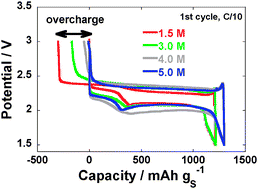Polysulfide dissolution control: the common ion effect†
Abstract
A Li–sulfur cell with a high discharge capacity of over 1300 mAh g−1 at a C/10 rate, and a controlled overcharge amount less than 1%, was manufactured by synthesizing a carbon–sulfur nano-composite via a wet milling process, and suppressing polysulfide dissolution using an electrolyte with a highly concentrated


 Please wait while we load your content...
Please wait while we load your content...